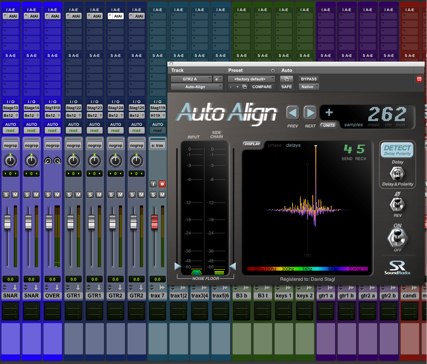
State of the Mix 2013 – Alignment

I’m on a little bit of an alignment kick again thanks to a plugin I found called Auto-Align by Sound Radix. Within a DAW, Auto-Align automatically calculates and applies the delay and/or polarity reversal necessary to best align two inputs to be in phase. Those two inputs might be multiple mics on a guitar amp, a mic’ed bass amp and a DI, top and bottom snare mics, etc, etc.
Unfortunately, there are presently no live consoles that this plugin can run on, however, it can still be a useful tool for calculating delay. I’m using this plugin to get alignment numbers for a few different inputs. First up I’m aligning my top and bottom snare mics to my overheads. Secondly I’m using it to line up pairs of guitar mics. I used to adjust this kind of thing by measuring waveforms in Pro Tools, but that got tedious over time so I started doing it by ear just listening to the low end. Using the plugin, however, has gotten me much tighter results.
To do this I built a Pro Tools session with a few different Aux inputs set to the inputs I want to line up. This session serves as my alignment template. Every week after I create my primary Pro Tools session for the week using VENUE Link, I’ll use the Import Session Data to import the Aux tracks from my template so that I can use the plugin.
So, let’s take the drums, for example. Auto-Align first needs to be inserted on all the tracks that are getting aligned. So in the case of the drums I have an instance on my stereo overhead, my snare top, and my snare bottom. Within each instance of the plugin, there is a Send and a Receive that need to be configured. I set the Send on the Overhead to “1” and the Receive on the snare tracks to “1”. This sets the Overheads as the sidechain input for the snare mics. I do it this way because I know that the snare sound is going to arrive later at the overheads than at the snare close mics. Then I just need someone to play drums.
With the drummer playing, I’ll typically adjust the noise floor fader on the sidechain so that only the snare hits are above the marker. Then I hit the “Detect” button and let the plugin do its magic. Once it’s finished, the number of samples needed to delay the top snare mic to be aligned to the overheads will be displayed in the plugin.
I then need to add the delay to my snare input on my console, and here’s where it can get a little complicated. If I’m using plugins on any of the inputs I’m aligning, there will already be delay on that input(s). In some cases, this might not be a big deal because the latency from plugins can sometimes be minimal enough in the case of the snare mic and overheads. The mics also tend to move around a bit on the riser so the amount of delay between the mics is something of a moving target.
However, in the case of some inputs, it can be important to compensate for any plugin induced latency. Fortunately, you can easily find out how much delay plugins add on the VENUE by selecting the input and right-clicking on the inserts to display the amount of latency/delay created by the plugins you already have inserted. These delays must then be subtracted from the Auto-Align number.
So, for example, let’s say that Auto-Align gave me a number of 110 samples to align the top snare to the overheads. 110 samples works out to about 2.3 milliseconds or about 2.5 feet away which sounds about right from eyeballing the mics. Then let’s say I already have 17 samples of delay on the snare top mic from plugins and 10 samples of delay on the overheads from a plugin. So I have 110-17-10=83 samples. I then set the console’s delay units to samples and add 83 samples of delay to the snare input.
Yes, it is a bummer to have to do math to implement this, but it’s easy math I can do on the fly during soundcheck. Like I said a few samples here and there probably won’t hurt on the drum side, but when aligning things like multiple guitar mics, they can make more of a difference.
Once the delay numbers are input, I find it’s important to test the results because using live inputs can sometimes give false results in the plugin. Sometimes it’s necessary to run the “Detect” process a couple of times to get a correct measurement. In the event that the result of the alignment isn’t clearly evident, flipping the polarity on one input is a good way to test the effectiveness of the alignment. Inputs out of alignment will typically lose their body and low end. Inputs in alignment will typically sound fuller and clearer.
I’ve been enjoying using this plugin, and I know when I’m doing studio work it will be a staple for mixing. Phase is a big deal, and this is just another tool for me to get it right.
UPDATE
My friend Mike Sessler just pointed out that my math above is wrong. If we’ve got 110 samples from Auto-Align, 17 samples of delay on the snare, and 10 samples of delay on the overheads, the correct way to do it would be 110-17+10=103 samples of delay. When dealing with latencies induced by plugins, I only need the difference in latency being applied since the rest will wash itself out. So I was off by 20 samples which works out to .4 milliseconds at a 48 kHz sample rate. Thanks, Mike!

 Previous Post
Previous Post Next Post
Next Post




Hi Dave- do all icon desks come with delay compensation as how pro tools 9 onwards has?
Since the ICON is a control surface that is only for Pro Tools, Pro Tools now has delay compensation built in.
Yes- I just saw update: agreed only d difference in total delay induce by plugins. However if there’s delay compensation kicking in, then leave out plug in delays! Don’t double compensate!
I have yet to find a live console that compensates for any latency from plugins or inserts on inputs.
http://www.avid.com/US/products/Profile-System/BundledVENUEPlugins
They do come with auto delay comp. so my take is if one wants to make OVH phase accurate with say d snare- then only introduce latency from your nifty plugin.
Delay compensation for plugins only applies to output busses on VENUE.
Ah apologies- I meant introduce delay which is calculated by the nifty plugin u raved about.
So currently in my room, we run both FOH and Monitors from a single Venue Profile and I don’t really know much about doing a split to a monitor board. So, I was wondering with your split going both to your FOH and monitor consoles, if/how you talkback to the band?
Good question. I generally don’t talk to the band through a talkback mic. If I need to talk to someone, 9 times out of 10 I walk to the stage. Outside of that, we have our com system tied into the monitor console so I can just use that.
So I’m guessing you’re not the kind of engineer that does the “kick drum… okay now snare drum…” soundcheck (EQ’ing each instrument or channel separately)? I’ve seen a lot of guys do either that or EQ while the band is playing a song.
Not typically. I’ll only do it that way if it’s a one-off, and that’s what the band is used to and comfortable with. But then I also rarely run soundchecks because I mostly mix FOH.